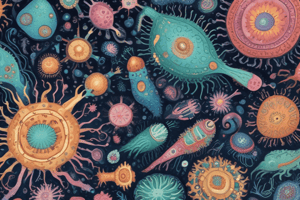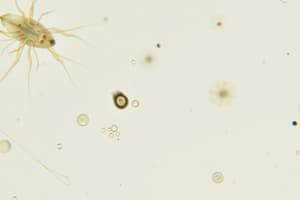Podcast
Questions and Answers
What method do most protozoa use to acquire particulate food?
What method do most protozoa use to acquire particulate food?
- Diffusion
- Pinocytosis
- Phagocytosis (correct)
- Osmosis
All protozoans possess highly functional mitochondria.
All protozoans possess highly functional mitochondria.
False (B)
What are the common structures used by protozoa for locomotion?
What are the common structures used by protozoa for locomotion?
Pseudopodia, cilia, and flagella
Protozoans typically acquire food by __________.
Protozoans typically acquire food by __________.
Match the following protozoan structures with their functions:
Match the following protozoan structures with their functions:
Which protozoan is known to have phagocytosed red blood cells?
Which protozoan is known to have phagocytosed red blood cells?
What structures are associated with reduced functions in some protozoans instead of typical mitochondria?
What structures are associated with reduced functions in some protozoans instead of typical mitochondria?
All known eukaryotes have mitochondria or related organelles.
All known eukaryotes have mitochondria or related organelles.
What structure is known to contain its own circular DNA within the mitochondrion?
What structure is known to contain its own circular DNA within the mitochondrion?
Syngamy refers to a form of asexual reproduction among protozoa.
Syngamy refers to a form of asexual reproduction among protozoa.
What is the primary function of contractile vacuoles in protozoa?
What is the primary function of contractile vacuoles in protozoa?
Binary fission is a type of ______ reproduction in protozoa.
Binary fission is a type of ______ reproduction in protozoa.
Match the following modes of reproduction with their descriptions:
Match the following modes of reproduction with their descriptions:
Which of the following statements about protozoan cysts is correct?
Which of the following statements about protozoan cysts is correct?
All intestinal protozoa are transmitted by the air.
All intestinal protozoa are transmitted by the air.
In which layer of the digestive tract wall are blood vessels and lymph vessels primarily found?
In which layer of the digestive tract wall are blood vessels and lymph vessels primarily found?
The ______ pathway transports substances between adjacent epithelial cells.
The ______ pathway transports substances between adjacent epithelial cells.
What is the primary purpose of the mucosal barrier in the intestinal tract?
What is the primary purpose of the mucosal barrier in the intestinal tract?
Study Notes
General Features of Protozoa
- Most protozoa are heterotrophic, obtaining nutrients by phagocytosis and enclosing food in food vacuoles.
- The cytostome is a specialized site for phagocytosis in some protozoa, for example, Balantidium coli.
- Protozoa exhibit diverse modes of locomotion, including using pseudopodia, cilia, or flagella.
- Protozoa can have various types of nuclei depending on the arrangement of the nucleolus.
- Some protozoa possess degenerate mitochondria-related organelles with reduced functions, such as hydrogenosomes and mitosomes, or structures associated with the mitochondrion like the kinetoplast.
Mitochondria & MROs
- The origin of mitochondria predates the divergence of eukaryotes
- All known eukaryotes have mitochondria, or mitochondria-related organelles (MROs) which are degenerate mitochondria with reduced function.
- The iron-sulfur cluster (ISC) pathway is ancestral in mitochondria and MROs.
Kinetoplast
- The kinetoplast is a spherical structure within the mitochondrion that contains its own circular DNA, kinetoplast DNA (kDNA).
- It is usually found near the kinetosome (basal body) but is not involved in motility.
- The kinetoplast is involved in DNA replication and synthesis of mitochondrial proteins.
- The kinetoplast changes its position during development in Trypanosoma.
Water balance & excretion
- Protozoa maintain water balance and excrete waste using contractile vacuoles.
Reproduction
- Protozoa reproduce asexually by binary fission, budding, and sexually by syngamy, autogamy, or conjugation.
- Binary fission involves multiple nuclear fissions before cell division, known as schizogony.
- Budding occurs when a new organism develops from an outgrowth, resulting in progeny cells smaller than the parent cell that grow to adult size.
- Syngamy is the fusion of gametes resulting in a zygote.
- Autogamy or self-fertilization occurs when gametes arise from meiosis and fuse to form a zygote within the same individual.
- Conjugation is the exchange of nuclear material between mating partners that form a temporary union.
- Protozoa can form cysts, which are resistant, external coverings with greatly reduced or inactive metabolism.
Intestinal Protozoa
- Many parasitic protozoa inhabit the gastrointestinal (GI) tract, the oral cavity, and the urogenital tract of animals.
- Many intestinal protozoa are transmitted via the fecal-oral route.
Layers of the Digestive Tract Wall
- The digestive tract wall consists of four layers, each with a specific function:
- Mucosa: The innermost layer, composed of the mucous membrane, lamina propria, and muscularis mucosa.
- Submucosa: A connective tissue layer containing larger blood and lymph vessels, immune cells, and the submucous (Meissner's) nerve plexus.
- Muscularis externa: The major smooth muscle layer, consisting of two layers: circular muscle (inner) and longitudinal muscle (outer). The myenteric (Auerbach's) nerve plexus lies between these layers.
- Serosa: The outer connective tissue covering, lubricates and prevents friction between digestive organs and surrounding tissues.
Epithelium
- Epithelium covers and lines body surfaces and separates the internal surface of an animal from the environment.
- Epithelial cells exhibit polarity, with an apical or luminal (mucosal) side and a basal or serosal side.
Intestinal Mucosal Barrier
- The intestinal mucosal barrier protects the body from pathogens and consists of an intrinsic barrier (tight junctions between epithelial cells) and an extrinsic barrier (mucus and other epithelial secretions).
- Mucus acts as a barrier to diffusion and pathogens.
- If the mucosal barrier is breached, pathogens encounter lymphocytes, neutrophils, and macrophages.
Epithelial Transport
- Substances are transported across the epithelium using three pathways:
- Transcellular pathway: Substances move through the epithelial cell by simple diffusion, facilitated diffusion, or active transport.
- Paracellular pathway: Diffusion occurs between adjacent cells.
- Transcytosis: Macromolecules are transported within vesicles through the epithelial cell via endocytosis and exocytosis.
Studying That Suits You
Use AI to generate personalized quizzes and flashcards to suit your learning preferences.
Description
Explore the fascinating world of protozoa and the evolution of mitochondria in this quiz. Learn about their diverse nutritional habits, modes of locomotion, and specialized structures like the cytostome and kinetoplast. Test your knowledge on the relationship between protozoa and their organelles.




